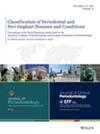Evaluating diagnostic accuracy and consistency in applying the 2017 periodontal classification among dental professionals.
IF 3.8
2区 医学
Q1 DENTISTRY, ORAL SURGERY & MEDICINE
引用次数: 0
Abstract
BACKGROUND Accurate periodontal disease diagnosis is essential for optimal treatment planning and patient care. However, variability in applying the 2017 Periodontal Classification may affect diagnostic reliability and treatment outcomes. This study investigated diagnostic accuracy and consistency among periodontists, periodontal residents, and dental interns in Saudi Arabia. METHODS Forty-four participants, including 13 periodontists, 14 periodontal residents, and 17 dental interns, independently classified 25 periodontitis cases. Agreement with a gold-standard diagnosis, established by expert periodontists using the 2017 Classification System, was assessed using descriptive statistics. Chi-square tests with Bonferroni-adjusted z-tests were used to compare agreement levels between rater groups. Inter-rater reliability was calculated using Fleiss' kappa, while Cohen's kappa was used to assess intra-rater reliability. RESULTS Periodontists demonstrated the highest agreement with the gold standard (92.0%) for periodontitis diagnosis. Staging agreement was highest among residents (51.7%) and periodontists (49.1%). Grading accuracy was highest for grade C cases across all groups (60.7%). Underestimation was common across rater groups, with interns exhibiting the highest rates in staging (49.6%) and grading (58.3%). The second assessment demonstrated improved diagnostic accuracy across all groups. Inter-rater reliability ranged from fair to moderate across rater groups (κ = 0.22-0.60). Intra-rater reliability was highest among interns, indicating substantial agreement (κ = 0.63-0.75). CONCLUSION Findings highlight considerable variability in the application of the 2017 Periodontal Classification among dental professionals, underscoring the role of clinical experience and training in influencing diagnostic accuracy. Structured calibration and targeted educational strategies are essential to improve diagnostic consistency, minimize misclassification, and support optimal patient care. PLAIN LANGUAGE SUMMARY Understanding gum disease correctly is important for providing patients with the right treatments. This study looked at how accurately different groups of dental professionals - specialists in gum disease (periodontists), dentists in training (residents), and recent dental graduates (interns) - could diagnose cases of periodontitis using a new system called the 2017 Periodontal Classification. A group of expert periodontists created a "gold-standard" diagnosis for comparison. We found that periodontists were the most accurate, while interns had more difficulty correctly identifying disease severity. Across all groups, many participants underestimated how serious the cases were. Participants were better at recognizing advanced disease compared to milder forms. When the participants repeated the diagnosis of the cases later, their accuracy improved, suggesting that practice and training help. Our results show that diagnosing gum disease can vary depending on experience and training. The study highlights the need for ongoing education and practice to make sure that all dental professionals can diagnose gum disease reliably, which is important for making treatment decisions and improving patient care.评估2017牙周分类在牙科专业人员中的诊断准确性和一致性。
背景:准确的牙周病诊断对最佳治疗计划和患者护理至关重要。然而,应用2017牙周分类的可变性可能会影响诊断的可靠性和治疗结果。本研究调查了沙特阿拉伯牙周病医师、牙周住院医师和牙科实习生诊断的准确性和一致性。方法对25例牙周炎患者进行独立分类,包括13名牙周病医师、14名牙周住院医师和17名牙科实习生。使用描述性统计评估与由牙周病专家使用2017年分类系统建立的金标准诊断的一致性。使用卡方检验和bonferroni调整z检验来比较评分组之间的一致性水平。评估者间信度采用Fleiss kappa,评估者内信度采用Cohen kappa。结果牙周炎诊断与金标准符合率最高(92.0%)。住院医师(51.7%)和牙周病医生(49.1%)的分期一致性最高。所有组中C级病例的评分准确率最高(60.7%)。低估在评分组中很常见,实习生在分期(49.6%)和评分(58.3%)方面的比例最高。第二次评估表明,所有组的诊断准确性都有所提高。评分者组间信度从一般到中等(κ = 0.22-0.60)。内部信度在实习生中最高,表明基本一致(κ = 0.63-0.75)。结论:研究结果显示,2017牙周分类在牙科专业人员中的应用存在相当大的差异,强调了临床经验和培训对诊断准确性的影响。结构化校准和有针对性的教育策略对于提高诊断一致性、减少错误分类和支持最佳患者护理至关重要。正确了解牙龈疾病对于为患者提供正确的治疗是很重要的。这项研究观察了不同群体的牙科专业人员——牙龈疾病专家(牙周病专家)、正在培训的牙医(住院医生)和最近的牙科毕业生(实习生)——使用一种名为2017牙周分类的新系统诊断牙周炎病例的准确性。一群牙周病专家创造了一种“黄金标准”诊断来进行比较。我们发现牙周病医生是最准确的,而实习生更难以正确识别疾病的严重程度。在所有小组中,许多参与者都低估了病例的严重程度。与轻度疾病相比,参与者更善于识别晚期疾病。当参与者稍后重复诊断病例时,他们的准确性提高了,这表明练习和训练有帮助。我们的研究结果表明,牙龈疾病的诊断可能因经验和培训而有所不同。该研究强调了持续教育和实践的必要性,以确保所有牙科专业人员都能可靠地诊断牙龈疾病,这对于制定治疗决策和改善患者护理非常重要。
本文章由计算机程序翻译,如有差异,请以英文原文为准。
求助全文
约1分钟内获得全文
求助全文
来源期刊

Journal of periodontology
医学-牙科与口腔外科
CiteScore
9.10
自引率
7.00%
发文量
290
审稿时长
3-8 weeks
期刊介绍:
The Journal of Periodontology publishes articles relevant to the science and practice of periodontics and related areas.
 求助内容:
求助内容: 应助结果提醒方式:
应助结果提醒方式:


